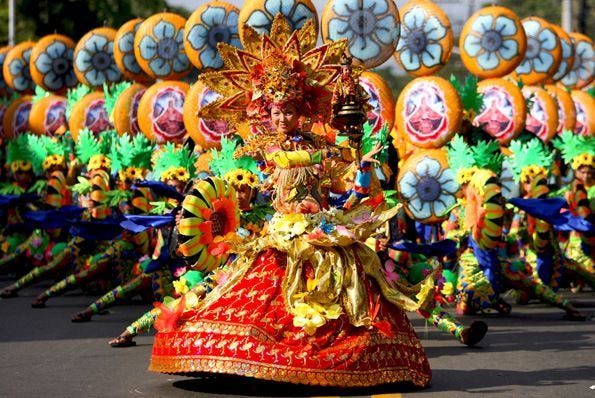Culture and Lifestyle in Cebu
Cebu is a kaleidoscope of varying cultures and lifestyles, a meeting of east and west, a fusion of things traditional and modern
This is influenced by the various phases of Cebu: being the spot where Philippine history began, becoming the cradle of Christianity, experiencing American and Japanese occupation, and later on transforming itself into a regional hub of everything from arts and craftsmanship, to business and information technology, all these, plus the convergence of personalities and groups from varying backgrounds give the island a culture and lifestyle that is uniquely Cebu

Food
Rice is the main staple for Cebuanos. being an island-province, fish (fresh or dried), crabs, seashells, shrimp and other sea foods are a common sight in most tables. Pork, chicken, and vegetables are equally accessible as well
Barbeque and puso (hanging rice or boiled rice wrapped in woven coconut leaves) have become customary. Fast-food abound, although international restaurants — whether European, Korean or something else, are everywhere
But what is most interesting in Cebu are the various delicacies native to each town and city comprising the province
These local food products are showcased during exhibits and when the caravan of the Provincial Government-initiated Suroy-Suroy Sugbo tourism program stops by in each place
Traditions and Fiestas
Famous among a myriad of festivities in the province are the Siloy Festival of Alcoy, Mantawi Festival of Mandaue City, Kadaugan sa Mactan of Mactan Island, Palawod Festival of Bantayan Island, Haladaya Festival of Daanbantayan
A must see also is the Sinulog Festival in honor of Señor Sto Niño de Cebu, which is celebrated every third Sunday of January
Sinloy Festival, celebrated every last Saturday of August, pays tribute to Patron Saint Rose of Lima, It promotes the Mag-abo Forest that shelters the renowned but endangered black shama (siloy)
Mantawi of Mandaue City illustrates the city’s heritage and identity as industrial center through floats, food festival, and trade fairs
The Kadaugan sa Mactan, meanwhile, commemorates the historic battle between the Spanish leader Ferdinand Magellan and Mactan Chieftain Lapu-lapu
Of the many islets in Cebu, perhaps the most well-known is the Bantayan Island. During their Palawod Festival every last week of June, locals and guests alike participate in street dancing, which captures the traditional fishing, a livelihood inherent in the island
The more than 40 festivals in Cebu province are highlighted in one grand event dubbed the Festival of Festivals, which is organized by the Cebu Provincial Government during its annual founding anniversary celebration every August.
Recreation
Being part of a tropical country, Cebu is lined with pristine white sand beaches perfect for weekend and holiday getaways. Famous resorts include Alegre Beach Resort in the municipality of Sogod, renowned for its white powdery beach and efforts in marine wildlife preservation
At the sunset coast of Cebu, another prominent tourist destination is the Badian Island Resort and Spa. A first class resort, it boasts of crystal blue waters, fine white sand beaches and the splendor of nature in the little island basking at Badian Gulf
Sanctuaries also abound in the province
One of these is the Olango Wildlife Sanctuary, six miles off the east coast of mainland Cebu. The island play host to a total of 77 species of migratory birds in the East Asian Flyway
For nature and butterfly lovers, a must see is the Jumalon Butterfly Sanctuary and Art Gallery. It houses about 53 butterfly species and different kinds of moths
Down south, Moalboal has the biggest Orchid Display in South East Asia, take in the majesty of vast orchid varieties from Asia, South America, and Hawaii which are cultured in the Orchid farm
Cebu province offers a wide range of recreational activities — from diving spots to golf courses, from heritage walks to eco-tourism adventures
In the metropolitan, entertainments centers thrive with vibrant discotheques and bars, specialty shops, savory restaurants and dining areas, internet cafes and distinct shopping malls
Religion
The most celebrated patron saint in Cebu is the Señor Sto Niño de Cebu, the Holy Child Jesus
The original statue is housed in the Basilica Minore del Sto Niño, near the famous cross erected by the Spaniards
Historical accounts say the image was given by the Portuguese Captain Ferdinand Magellan to the wife of Cebu Chieftain Raja Humabon for their pledge of allegiance to the King of Spain, the majority of the population in Cebu are Roman Catholics
Spanish-era churches are dotting the coasts of Cebu province
One of the oldest churches in Central Visayas is the one in Boljoon, Cebu, which is more than 400 years old and is currently undergoing renovation
Literature
Cebuano literature, as most literary works in the Philippines, started with fables and legends of pre-colonial Philippines along with Spanish influences. Since the local alphabet was not widely spread in the Visayas, most of the literature produced was oral, handed down to generations. These were documented by the Spanish Jesuit Fr. Ignatio Francisco Alzinal
During the American period, Vicente Sotto, now called the Father of Cebuano Literature, wrote the first short story Maming and was published in the first issue of his newspaper, Ang Suga. Sotto’s reputation as a playwright started after he wrote and directed the first Cebuano play entitled Elena


I’ve always wanted to experience Sinulog! What’s it like?
Sinulog is incredible! So colorful and lively—imagine street dancing, music, and the entire city coming together. It’s a celebration you won’t forget!
What’s the best time of year to visit Cebu?
December to May is ideal—cooler weather, and you’ll catch the Sinulog Festival in January if you’re around! Just avoid the rainy season around June to October.